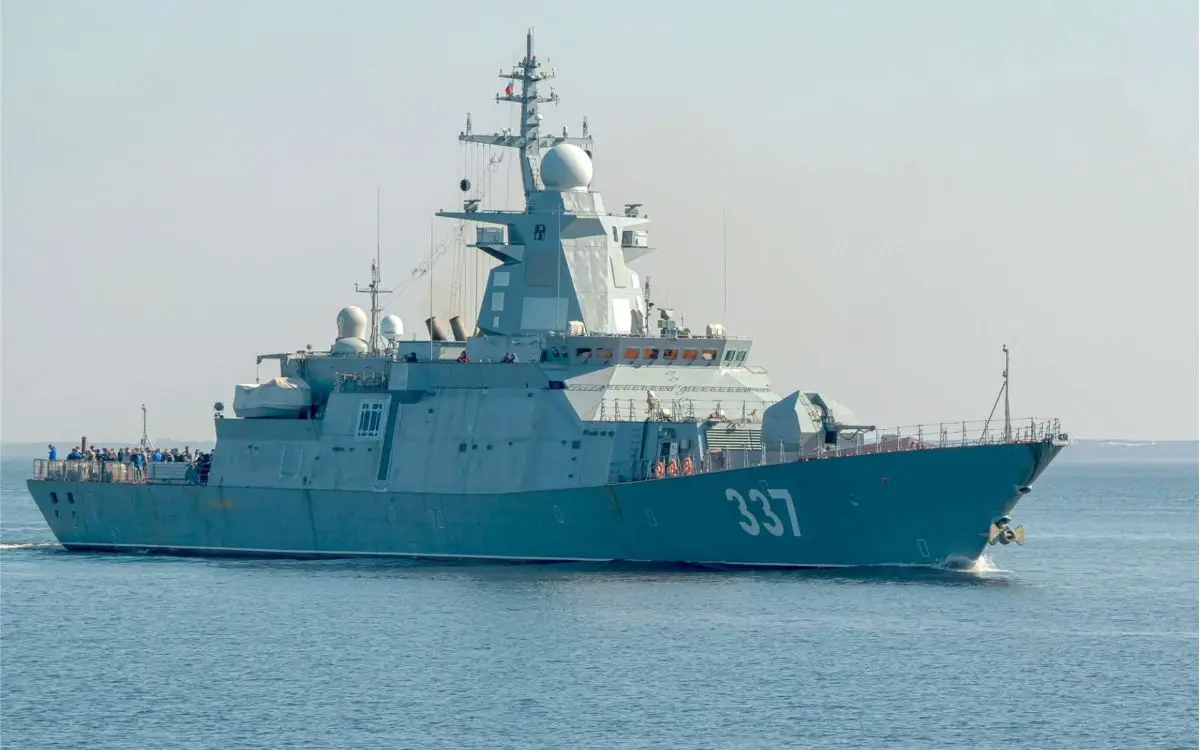Breaking News
Russian Navy upgrades Pacific Fleet's Project 20385 Gremyashchiy-class corvettes with Zircon hypersonic missiles.
According to several Russian newspapers on July 1, 2024, at least two Russian Project 20385 Gremyashchiy-class corvettes have been upgraded to launch Zircon hypersonic missiles. These upgrades have been implemented on the Gremyashchiy and Provornyy corvettes, which are part of the Pacific Fleet. These modifications enable the corvettes to engage ships of similar classes, including frigates, destroyers, and even aircraft carriers.
Follow Army Recognition on Google News at this link

The lead vessel, the Gremyashchiy, which joined the fleet in late 2020, has had its universal naval firing complex (UKSK) 3S14 upgraded to accommodate eight missile cells. This adaptation allows for the launch of Kalibr cruise missiles, Onyx anti-ship missiles, and Zircon hypersonic missiles. (Picture source: Russian social media)
Sources within the Russian shipbuilding industry have confirmed that the current focus is on the Pacific Fleet's two corvettes. The lead vessel, the Gremyashchiy, which joined the fleet in late 2020, has had its universal naval firing complex (UKSK) 3S14 upgraded to accommodate eight missile cells. This adaptation allows for the launch of Kalibr cruise missiles, Onyx anti-ship missiles, and Zircon hypersonic missiles. The Provornyy, launched in 2019, experienced severe fire damage in 2021, delaying its commissioning to 2024. Despite the damage, extensive repairs have been completed, and the vessel is nearing completion at the Severnaya Verf shipyard in St. Petersburg. During its construction, the Provornyy received the modernized UKSK 3S14 system, making it capable of carrying Zircon missiles from the outset.
It is not yet confirmed whether other corvettes under Project 20380 Steregushchiy-class and Project 20385 Gremyashchiy-class, currently being constructed at Severnaya Verf and Amur Shipyard, will be similarly equipped, although it is anticipated they will be. It is known that the integration of Zircon hypersonic missiles for these two classes follows similar enhancements made to the vessels of the Project 22350 Admiral Gorshkov-class frigates.
The 3M22 Zircon, also designated as 3M22 Tsirkon (NATO reporting name: SS-N-33), is a Russian hypersonic cruise missile intended for multiple purposes, including anti-ship, land-attack, and submarine-launched missions. The Zircon missile measures approximately 9 meters in length with a diameter of 60 centimeters and carries a warhead that can accommodate high-explosive (HE) or nuclear payloads. It has a maximum firing range of 1,000 kilometers and can reach a maximum speed of Mach 9 (6,900 mph; 11,000 km/h; 3.1 km/s). This speed makes it challenging for existing missile defense systems to intercept, enhancing its effectiveness in penetrating enemy defenses. Additionally, the hypersonic speed of Zircon generates a plasma cloud during its hypersonic cruise phase, absorbing radio waves and making it difficult to detect by active radar systems.
The missile's flight profile involves a booster stage with solid-fuel engines for supersonic acceleration, followed by a scramjet motor in the second stage for hypersonic flight. It operates at altitudes of up to 28 kilometers (92,000 feet) and can cover different ranges, from 135 to 270 nautical miles (250 to 500 kilometers) at low altitudes and up to 400 nautical miles (740 kilometers) in a semi-ballistic trajectory.

The 3M22 Zircon, also designated as 3M22 Tsirkon (NATO reporting name: SS-N-33), is a Russian hypersonic cruise missile intended for multiple purposes, including anti-ship, land-attack, and submarine-launched missions. (Picture source: Russian social media)
Russian military expert Dmitry Kornev noted the strategic impact of these upgrades, stating that the corvettes can now engage ships of similar classes, including frigates, destroyers, and even aircraft carriers. Kornev mentioned that to penetrate the defenses of an aircraft carrier strike group (ACG), several ships might be needed, but eight hypersonic missiles from a single corvette could be enough to target and potentially neutralize an aircraft carrier.
The modernization also aligns with recent statements on the development of the Russian Navy. Russian President Vladimir Putin indicated that the Navy's capabilities in strategically important areas of the World Ocean are to be strengthened, and Viktor Yevtukhov, State Secretary and Deputy Minister of Industry and Trade, stated that the fleet is expected to receive around 50 ships and support vessels this year, including submarines, frigates, corvettes, small missile ships, and support vessels.
The Russian Project 20385 Gremyashchiy-class corvette is an evolution of the Project 20380 Steregushchiy-class corvette, designed for multi-mission operations within the Russian Navy. A significant change in the Project 20385 class compared to its predecessor is the replacement of the two four-container launchers for the Kh-35U "Uran" anti-ship missiles with a more flexible eight-cell Universal Shipborne Firing Complex (UKSK) to support various missile types, including Kalibr, Oniks, and Zircon. Additionally, Project 20385 corvettes have a higher displacement at 2,430 tons and are slightly longer at 106.3 meters to accommodate these capabilities.
Technological updates in Project 20385 include the introduction of the Zaslon multifunction radar system, which replaces the older Furke-2 and Monument-A systems. This upgrade enhances the ship's capabilities in target detection and tracking. The air defense capabilities are also enhanced, with an increase in the vertical launch system (VLS) cells for the Redut air defense missile system from 12 to 16 cells compared to Project 20380. The propulsion remains consistent with the previous model, using two DDA-12,000 diesel engines that generate a combined output of 24,000 horsepower, allowing for a maximum speed of 27 knots and a cruising range of 4,000 nautical miles at 14 knots.
Project 20385 corvettes are designed with a modular architecture, facilitating potential upgrades and maintenance, extending their operational viability. Stealth features are incorporated through the use of composite materials and radar-absorbing coatings to reduce the radar cross-section. The automation within the ships allows for a reduced crew size of approximately 100 personnel, including 14 officers. These corvettes are engineered to operate in higher sea states, supporting a wide range of naval missions from anti-submarine warfare to surface combat engagements and providing naval gunfire support.


























